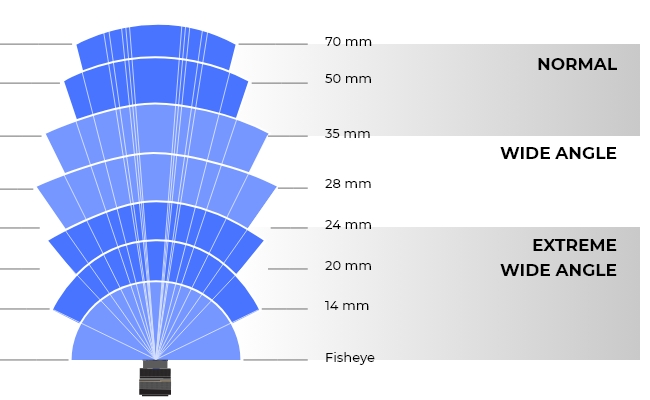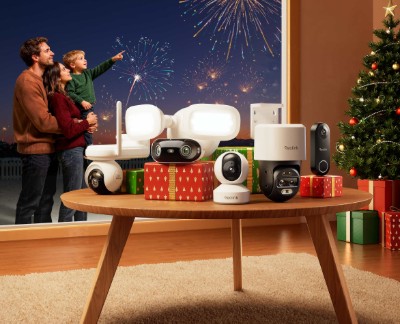What is Wide Angle Lens? Everything You Should Know

The biggest concern of beginner photographers is the type of camera lens they should buy. A wide-angle lens is a popular option and could be a perfect choice for certain purposes.
In this article, we'll discuss what a wide-angle lens is and its uses. We'll uncover the secrets to choosing the best wide-angle camera and how to click the best pictures.
Reolink New Year Sale - Save Big with Exclusive Deals!
Save big with Reolink! New Year Sale up to 45% off on security cameras, doorbells, and systems — Dec. 8 to Jan. 4.
What is a Wide-Angle Lens?
A wide-angle lens is a special lens capable of capturing a wider field of view in images. It takes extra wide scenes in a frame, so it is possible to capture more objects/persons and larger landscapes.
In simple words, a wide-angle lens fits more stuff than a normal lens. It covers more in a frame, which normal lenses crop.
These lenses have a focal length of 35mm or shorter to capture a wide view. They are available in both fixed focal length and zoom versions according to the preferences and needs of photographers.
Types of Wide-Angle Lens
Wide-angle lenses are divided into four types, which are:
-
Standard Wide-Angle Lens: A wide-angle lens having a focal length between 35mm and 24mm is called a standard wide-angle lens. This is the range from where wide-angle lenses start.
-
Wide-Angle Lens: These lenses have a focal length of 24mm to 16mm. They offer a wider frame than the previous one. They are suitable for capturing any scene requiring a larger view than a normal camera, such as group photos.
-
Ultra-wide Angle Lens: They have a focal length below 16mm. You might even see ultra-wide angle cameras in your smartphones, such as the iPhone 15, which offers a 13mm equivalent ultra-wide camera. You can use them to capture open fields, mountains, beaches, etc.
-
Fish-eye Lens: This extreme level wide-angle camera captures a massive scene in its frame. Its focal length is 8-10mm, offering a 180⁰ field of view. They are great at capturing stars in the sky and architecture.
What is a Wide-Angle Lens Used For?
Wide-angle lenses have special uses because of their wide field of view.
Landscape Photography
A wide-angle lens can cover a massive landscape in one shot. Ultra-wide angle cameras are great for this purpose, and they can capture a big area with tons of stuff packed in a single frame. You can take pictures of a beach, river, farm, mountain, etc.
Architecture Photography
It is difficult to capture an architectural piece in a frame captured through a normal lens. But a wide-angle lens can do wonders.
It can capture the whole exterior or look of the architecture, giving the viewer a complete idea. It is perfect for doing architecture photography as well as real estate photography.
Event Photography
When you need to capture groups, large gatherings, and tons of stuff in a single image, that's where a wide-angle lens comes into play. In any event, whether it be a wedding, party, corporate gathering, etc., you need a wide-angle lens along with others. It helps you pack more people and important stuff in a single photo.
Street Photography
You can't capture the beauty of a street through normal lenses. You need ultra-wide angle lenses to capture houses, graffiti, mesmerizing architecture, people, and many things in a frame. It helps you capture the essence of streets and places and convey many messages.
Security Monitoring
For outdoor surveillance, especially if the area is too large, camera with wide-angle lenses are incredible. Instead of multiple cameras, you can use one to get more details in a frame.
Due to the wide field of view, you can monitor and track the movement using the camera. Keep an eye on the whole backyard, garden, driveway, front road, or any other place in just one frame.
Security cameras are also come with wide-angle view. One such example is the Reolink Duo 3 WiFi. This security camera combines two lenses into one device, creating a 180-degree field of view.
Groundbreaking 16MP Dual-Lens WiFi Camera
16MP UHD, Dual-Lens, Motion Track, 180° Wide Viewing Angle, Plug-In WiFi, Color Night Vision.
Reolink Duo 3 PoE also provides wide-angle field of view. It is an incredible piece of state-of-the-art technology. It contains a dual camera that captures a wide field of view of about 180⁰. The 16MP resolution also ensures fine details and incredibly crisp and clear images.
Groundbreaking 16MP Dual-Lens PoE Camera
16MP UHD, Dual-Lens, Motion Track, 180° Wide Viewing Angle, Power over Ethernet, Color Night Vision.
Another excellent option is the Reolink TrackMix WiFi, which offers advanced motion tracking capabilities and a dual-lens 4K camera. It combines wide-angle and zoomed-in views to track moving objects with precision.
4K Dual-Lens PTZ Camera with Motion Tracking
4K 8MP UHD, Wide-Angle & Telephoto Lenses, Pan-Tilt-Zoom, Auto-Tracking, Person/Vehicle Detection, 2.4/5 GHz Dual-Band WiFi, Two-Way Audio.
What Do You Consider When You Choose and Use the Wide Lens?
How to Choose Good Quality Wide Angle Lens
There are a few things you need to consider while buying a wide-angle lens.
- Field of View
We have discussed the types of wide-angle lenses, and you need to choose which one is the best for your needs. All these types of lenses offer a distinct field of view.
A standard wide-angle lens has a focal length between 35mm to 24mm, offering a field of view of 64⁰ to 84⁰. If you need a wider field of view, you can go with ultra-wide angle lenses that offer 84⁰ to 114⁰ field of view.
For an extreme level, you can go with a fish-eye lens that offers a 180⁰ field of view. Now, you can choose according to your needs.
- Lens Distortion
You also need to understand the distortion in wide-angle lenses. It makes a straight line appear curved.
When you over a lot in a frame, distortion happens, and this increases with the increase in the field of view. Thus, a 35mm camera will have less distortion than a 16mm camera.
- Fixed Focus or Zoom
You can get both fixed focus and zoom versions of wide-angle lenses.
The fixed focus lenses offer incredible image quality, and they are affordable. If you want to take your photography skills to the next level, these are great. However, due to fixed focus, their usage becomes limited.
Zoom lenses allow you to adjust the focus according to your needs. This adjustment adds an extra mechanism to the lens, which makes it more expensive. It can be used for a wide range of purposes, but its image quality is a bit inferior to the fixed-focused lens.
How Do You Properly Use a Wide-angle Lens Camera?
Using a wide-angle lens is an art. It requires effort and time to ace the features and click amazing pictures. Here are a few tips to use a wide-angle lens properly.
- Distortion
Wide-angle lenses distort the objects in a photo and make them appear to be curved like a bow.
This distortion increases with the field of view. If you want to avoid it, go for a focal length near 35mm. Understand the objects and things in the background and analyze what is going to distort. Then, click photos at the right spot.
- Cropped Sensor Conversion
If you place a wide-angle lens on a cropped sensor camera, you won't be able to enjoy the complete field of view that the lens could offer. Some portions will be cropped, which will look like an image taken from a normal photo.
Do not place your wide-angle lens on a cropped sensor camera. Choose the right camera to enjoy a wide field of view.
- Composition
When you capture more information, items, and objects in an image through a wider field of view, the viewer might struggle to focus on the main thing at a glance.
Pay attention to every detail that's going to be in the frame. Adjust the placement of the person or main subject at the right place. You need to click an image that draws the viewers' attention to the main subject without struggling.
Wide Angle Lens vs Telephoto vs Fish-eyes: What's the Difference?
Wide-angle Lens vs Telephoto
Wide-angle and telephoto lenses are the opposites.
Wide-angle lenses fit more stuff and capture a wider scene in the photo. They offer a wide field of view to capture a more detailed background.
In contrast, telephoto lenses focus on a certain object. They capture close-up shots with more details of the main subject. You don't see much of the background or things around the image as the field of view is much less compared to the wide-angle lenses.
Suppose someone is standing on a beautiful icy mountain. If you use a telephoto lens, you'll capture the person with incredible details and a crisp and clear image. But if you use a wide-angle lens, you'll capture tons of things around the person. It will give a wider view of the place.
Fish-eye vs. Wide-Angle Lens
A fish-eye lens is a type of wide-angle lens. It has a focal length of 8mm, which captures a 180⁰ view in a frame.
When you look at the fish-eye image, it appears to be seeing the whole world from a tiny hole.
In contrast, wide-angle lens is a category that includes different types of lenses, including the fish-eye lens. These have a focal length below 35mm.
FAQs
1. Does a Wide-Angle Lens Zoom?
Wide-angle lenses are available in fixed focus and zoom. You can get a zoom lens if you need to adjust the focus. However, it would be a more expensive option.
2. What is a wide-angle lens vs. a regular lens?
A wide-angle lens captures a wide area. It has a wider field of view, so you can capture more scenes, objects, and people. A regular camera offers a cropped version of the image; its field of view is the same as the human eye.
3. When should you not use a wide-angle lens?
When you want to focus on a certain object or take a close-up picture, a wide-angle lens is not the right choice.
Conclusion
A wide-angle lens camera can fit a ton of stuff in a frame, making it ideal for various purposes. We have discussed the types of wide-angle lenses and how you can select the best one. You can decide according to your usage. Remember that a wide-angle lens camera requires practice and patience. It is a bit difficult to handle as a beginner, but you can follow the best practices we have discussed.
Search
Subscribe for the Latest Updates
Security insights & offers right into your inbox




